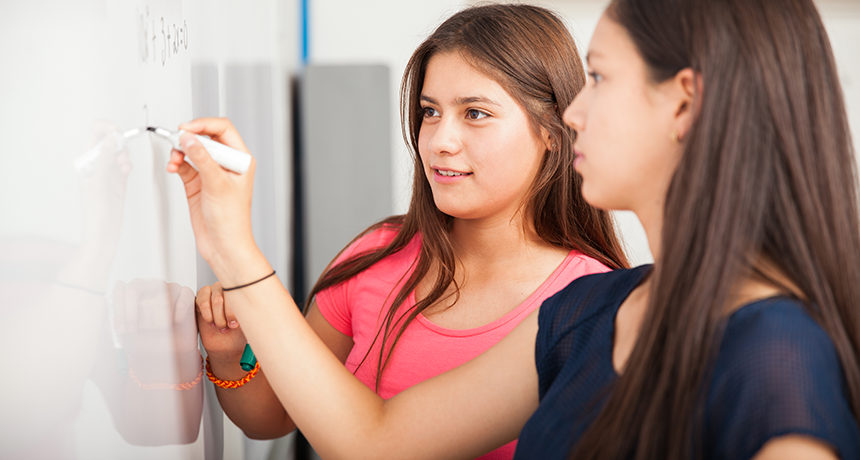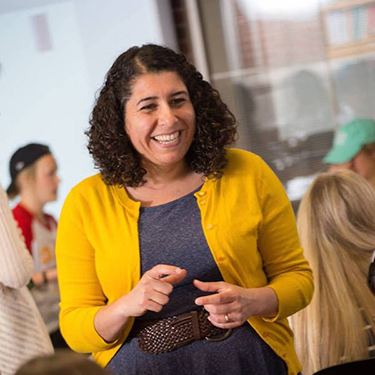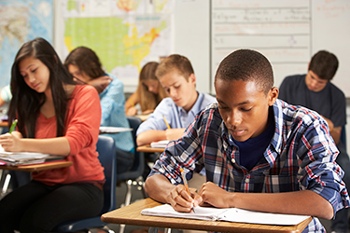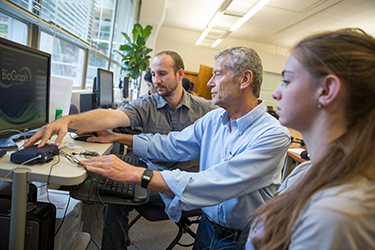Science is helping kids become math masters
Experts develop strategies to help more students succeed in this oft-dreaded subject

Two girls work together solving a math problem in class. Such collaboration in class may represent a new approach to learning math better.
Antonio_Diaz/iStock/Getty Images Plus
Math is one four-letter word that leaves many teens anxious and sweaty. The idea of an impending math test might send shivers down their spines. Some kids avoid their homework — or at least delay starting it — because they find math so daunting. Their minds might even go blank at the sight of test questions, no matter how well they have studied. If this is you, there’s some comfort knowing that you’re not alone.
It’s hard to pinpoint how many people suffer stress or anxiety just thinking about math. But it’s common. In fact, math anxiety can strike even mathematicians. So having this condition does not mean you’re bad at math or doomed to fail. And there are tips that can help you overcome this anxiety.
There’s always hope, says Patrick Honner. “We’re in control of math. Math isn’t in control of us,” says this teacher at Brooklyn Technical High School in New York City. Honner also writes a math column for Quanta Magazine, where he shares basic math concepts from recent research.
Even people who are not math-anxious can gain more confidence and skill to better succeed with numbers. How to help students excel in math is even becoming a hot research topic. And some emerging innovations might show up soon in a classroom near you.
Swapping out homework for videos
Math classrooms have tended to be where teachers lectured on new concepts and drew all over whiteboards. Home is where students then attempted to put into action what they learned. But some math classrooms have now begun flipping that approach.
In-class time is now where the bulk of solving problems takes place — often in groups that also talk over the topics they’re learning. The goal of this switch-up is to help kids better connect with math and each other. As for lectures? Kids get those at home through videos, online information and more.
Flipped classrooms are “something that a lot of people have been talking about for many years,” Honner says.
Researchers have been curious about whether kids master math better in flipped classes. Zandra de Araujo is among them. She studies math education at the University of Missouri in Columbia.
Since 2017, her team has been observing 40 Missouri classrooms. Half are flipped. The others aren’t.

These classrooms all teach algebra. It’s a type of math that uses symbols called variables — letters (such as x’s and y’s) that stand in for numbers. The equation 3x + 4 = 16 is an example of algebra. (To find the answer, first subtract 4 from both sides. Next, divide each side by 3. That gives you the solution: x = 4.)
De Araujo’s team is exploring which classroom approach seems to work best. Each student in the study takes a test at the start of the school year. At the end of the year, they all take another and the researchers compare the results. Teachers also are being surveyed for their impressions. The study should be done by the middle of next year, de Araujo says.
Her team is finding that there “are a lot of different ways to flip a class,” she says. Some kids first learn new concepts by watching at-home videos. Kids in other classes have the chance to first explore new things in class through problem-solving. And while some kids can work at their own pace, others are told to keep to the class schedule. Kids who don’t have internet access at home have different options for getting the lecture materials they need, de Araujo notes.
The flipped-classroom idea hinges on the notion that teachers “should be making better use of class time with students,” Honner says. But flipping a class isn’t the only way to do that.
Indeed, Honner doesn’t use that approach. Each year, he teaches between 100 and 170 students. With numbers like those, it can be difficult for all the teens to build a rapport with their teachers. Yet Honner believes those bonds are crucial. He often poses math questions to kids in his classes, then lets the students discuss the questions in groups. Later, the entire class talks about the questions together.
And sometimes he uses class time for lectures. “I don’t plan a lesson as ‘I need to say all of these things,’” he says. Instead, he thinks about which math ideas he wants kids to “engage with.” He then plans his lessons around those ideas.
Honner even sees a few potential downsides to flipping. Many video lectures aren’t interesting, while “a good [in-class] lecture can be very engaging,” he says. (This can depend heavily on a teacher’s style, personality and energy.) Kids can watch videos at different paces, but “when you pause or rewind, you’re just watching the same video again,” he says. Students don’t get to go as deep as they might with a teacher. Finally, with flipping, kids miss the chance to ask questions during the lecture and learn from other kids’ responses.
Tackling anxiety with good posture

Videos and other types of technology aren’t always needed to improve math performance. Some students can get a boost from something as simple as sitting up.
Math anxiety can make it hard to retain new concepts and to perform well on tests and assignments. People who find math overwhelming may start to tune out and slouch in their seats. Erik Peper wanted to investigate how posture might affect math performance.
Peper is a health researcher at San Francisco State University in California. His team recruited 125 college students for its study. The team asked students to mentally subtract large numbers. Half were told to slouch. The rest were directed to sit upright. For 30 seconds, each student started with the number 964 and then silently subtracted by sevens. Then they switched positions and repeated the exercise, this time starting from the number 834.
A survey asked each person which position made it easier for them to do the mental math. More than half (56.4 percent) found those calculations easier when they sat upright. One sixth (18 percent) said it was easier when they slouched. The rest said posture didn’t matter.

More interesting was which students struggled most while they slouched. The study had asked students to rate their test anxiety, math performance, depression, anxiety and “blanking out” during exams. Those who had the hardest time performing mental math while slouching were the 30 percent who also struggled most with test anxiety, math and other related concerns.
Peper’s team reported its findings in June 2018 in NeuroRegulation. Peper now recommends sitting upright when math anxiety hits. Good posture might help students get into the abstract-thinking mode that will help them succeed in math, he says.
Honner agrees. “Good posture is important. Sitting properly leads to sort of better health and feeling better,” he maintains. But Peper’s posture research “seems like a limited study,” Honner adds. Sitting up certainly can’t hurt. But until more research confirms this study’s findings, he says, “I’d be hesitant to draw big conclusions from it.”
Video games for geometry gains
Candace Walkington is probing whether a new video game might help teens learn geometry, the math of shapes. She studies math learning at Southern Methodist University in Dallas, Texas. Her work focuses on helping students connect abstract math ideas to their life experiences.
People “understand ideas by using their bodies,” says Walkington, “and this includes math ideas.”
Walkington and her colleagues use a video game called “The Hidden Village.” Right now, the game runs only on computers that are equipped with Kinect motion-capture cameras, she notes. That technology provides each student an avatar whose body moves in the game when the student moves in the real world.
In the game, players interact with different villagers who fish, dance, basket weave and more. Players must also perform these tasks in the game by making the motions in real life. But the motions are tied to something bigger. Walkington is looking at how movement might help teens learn how to prove statements from geometry. (In math, a proof is a step-by-step way of showing that a given statement is true.)
After players learn the moves, they’re given a new statement from math. To advance in the game, they must decide whether the statement is true or false. Walkington’s team records the teens explaining why they think these statements are true or false. (Here the players might use the motions they learned earlier in the game to explain their reasoning.) They also choose some answer from a multiple-choice list that best explains why they think the statement is true or false. For each proof activity that is completed, a player earns a token and a piece of the village map.

Which motions the teens make in the game aren’t always ones that are related to the math statements the game later presents to them. Walkington wants to know whether it matters if the movements are related to those statements.
For instance, the teens might be given a problem about triangles. Earlier in the game, one student might be told to move her arms to form different parts of a triangle. Another teen might be instructed to make motions that are actually designed to go with a rectangle problem.
The team is still analyzing data from the project.
Group effort
Walkington’s team has already published research in the Journal of Mathematical Behavior. That study included 51 high school students who hadn’t taken geometry before. It focused on what happened when students worked in groups of twos or threes on the math problems in the game.
The scientists looked at whether the teens could correctly determine at first glance whether the statements were true or false. They called this “intuition” (In-too-IH-shun). They also measured whether each group’s work showed that they understood the math ideas behind the problems they were solving. The scientists called this “insight.” And they looked at whether the groups created valid proofs for the statements each had been given.
The results of that study? When students in groups made any type of gestures, they had the correct intuition 56 percent of the time and the correct insight 48 percent of the time. When they worked together to make gestures to solve math problems, the groups of students had the correct intuition 70 percent of the time. And they had the correct insight 72 percent of the time. What’s more, groups who didn’t make any gestures had the correct intuition just 27 percent of the time. They also had the correct insight a mere 12 percent of the time.
The motions didn’t increase the teens’ chances of creating valid proofs by much. Still, this study shows that teamwork combined with movement can be a powerful problem-solving tool. It “enhances the quality of their reasoning,” the team wrote.
Honner says he “would keep an eye on” this geometry game. “It could be that there’s a space for these motion-capture games in geometry.” He thinks it’s important that classroom math games are “really about math” and not some “superficial layer on top of mathematics.” Students in his classes already use technology tools such as 3-D printing and computer programming to enhance their learning.
What you can do now
You don’t have to wait for your school to roll-out new classroom strategies. A huge part of the formula for math success relies on you thinking about math in a certain way. Honner advises approaching it “as if you’re trying to make sense” of it. Don’t view it as just a sheet of paper listing problems to solve.
Math is “like a big puzzle,” he says. “And the goal is to understand how all the pieces fit together.” Accept that it may take hard work to really make sense of it. Realize, too, that math is a part of what’s all around you, he says. In fact, “look for ways that math impacts your life.”
Math seems more useful when you realize that it’s an important part of understanding you, your community and even ecosystems around you. Even when you’re frustrated, remember: Math usually is not pointless. It’s a way to better predict or make sense of our world.







